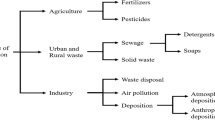Abstract
Background
Aims, and Scope. Reducing heavy metal solubility and bioavailability in contaminated area without removing them from the soil is one of the common practices in decreasing the negative impacts on the environment and improving the soil quality. Therefore, our aim was to study the effect of clay minerals: Na-bentonite, Ca-bentonite, and zeolite applied to a contaminated soil on immobilization of heavy metals, as well as on some soil parameters related with microbial activity.
Methods
A soil derived from sewage sludge was incubated with clay minerals of either Na-bentonite, Ca-bentonite, or zeolite for 111 days (d). During the incubation experiment, concentrations of water soluble Zn, Cd, Cu, and Ni were measured after extraction of 2 g air-dry soil with 50 ml of H2O for 2 h. After the water extraction, the soil sediment was extracted with 50 ml of 1 M NH4NO3 for 2 h to estimate the exchangeable amounts of heavy metals. Furthermore, soil microbial respiration, microbial biomass C, Corg mineralization, metabolic quotient (qCO2), and inorganic N were also investigated.
Results and Discussion
Water extractable and exchangeable forms of heavy metals were changed by incubation and addition of clay minerals. Incubation of soil without addition of clay minerals (control) increased water extractable Cu by 12, 24 and 3.8% of initial content after 21, 62, and 111 d of incubation, respectively. The water extractable Zn decreased by 9% during 62 d of incubation and it tended to increase by 14% at the end of the incubation, as compared with the initial soil. Water extractable Cd decreased by 71, 66 and 33% of initial content, and Ni decreased by 54, 70, and 58%, after 21, 62, and 111 d of incubation, respectively. During the incubation experiment, the exchangeable form of all tested metals was decreased by incubation. The addition of clay minerals led to a significant decrease in water soluble and exchangeable forms of heavy metals during the incubation experiment, resulting in low metal extractability. The reduction in metal extractability was greater due to the addition of Na-bentonite or Ca-bentonite than that due to the addition of zeolite. During the first 3 weeks after addition of clay minerals, the studied biological parameters were not affected. However, as incubation progressed, the addition of Na- or Ca- bentonite led to a significant increase in soil respiration, microbial biomass C, Corg mineralization, and inorganic N; and a significant decrease in qCO2. This result is explained by sorption of heavy metals on Na-bentonite and Ca-bentonite and strong reduction of their toxicity.
Conclusions
Our results clearly show that the addition of clay minerals, especially of Na-bentonite and Ca-bentonite, decreased the extractability of four metals during incubation. The decreased metal extractability was accompanied by an increase of soil respiration, Corg mineralization, microbial biomass C, and inorganic N and a decrease of metabolic quotient (qCO2), showing positive effect of clay mineral addition on soil biological parameters.
Recommendations and Outlook
The use of Na-bentonite and Ca-bentonite is promising tool for reduction the extractability and possible toxicity of heavy metals in sewage sludge-contaminated soil. Therefore, the soils polluted with heavy metals may be ameliorated by addition of clay minerals, especially Na-bentonite and Ca-bentonite.
Similar content being viewed by others
Author information
Authors and Affiliations
Corresponding authors
Rights and permissions
About this article
Cite this article
Usman, A., Kuzyakov, Y. & Stahr, K. Effect of Clay Minerals on Immobilization of Heavy Metals and Microbial Activity in a Sewage Sludge-Contaminated Soil (8 pp). J Soils Sediments 5, 245–252 (2005). https://doi.org/10.1065/jss2005.05.141
Received:
Accepted:
Published:
Issue Date:
DOI: https://doi.org/10.1065/jss2005.05.141




